You can check out Part 1, Part 2, and Part 3, of this appalling account of congressional and Obama-nal malfeasance at the links.
Fake Translations & Forged Documents
On a website Bill Browder runs promoting his version of Sergei Magnitsky’s imprisonment and demise in the custody of Russian authorities, he links to a document formatted like a collection of PowerPoint slides called Magnitsky Murder and Cover-up Report.
Slide number 18, titled Magnitsky Is Beaten With Rubber Batons, tells us that:
[A] team of eight riot troopers placed [Magnitsky] in an isolation cell, handcuffed him to a bed and beat him with rubber batons.
If we’re charitable and allow that “handcuffed” and “chained” are synonymous and don’t raise a fuss over the riot guards also being the ones who placed him in his cell, it’s the same story Browder told to Congress in 2012 discussed in Part 2.
But, unlike Browder’s testimony to Congress, slide 18 foregoes the ridiculous claim that the information comes from a complaint Magnitsky somehow managed to write and submit while they were beating him to death.
And, though the Moscow Public Oversight Commission (MPOC) report discussed in the previous entry is mentioned in a footnote, the main corroboration Browder provides are links to two untranslated Russian documents described as Report on Use of Handcuffs (D309.pdf) and Report on Use of Rubber Batons (D310.pdf). (All translation by Dmitri Toptygin.)

But, as you can see from the above English-language translation, the first appears to be an official form titled About the application of handcuffs issued by the Russian government to provide an explanation for incidents in which a prisoner is subjected to the “special means” of being handcuffed.
And, apart from not mentioning batons or saying anything about Magnitsky being beaten, it explicitly states that he was placed in handcuffs—not as the story Browder claims it corroborates says—to harm him but, rather, to stop him from harming himself.
Moreover, this accords exactly with the MPOC report. It tells us that, on the night he died, Magnitsky began to act very erratically, the doctor thought his behavior “looked like acute psychosis and delirium of persecution,” so “[t]hey called for Psychiatric Emergency” who then “put handcuffs on Magnitsky’s hands.”
The other Russian document that Browder links to for corroboration also, instead, refutes his story. As you can see from its English-language translation below, it looks like another government form that, for some strange reason, echoes exactly what the previous one said about handcuffs and adds that a single rubber baton was used as well.
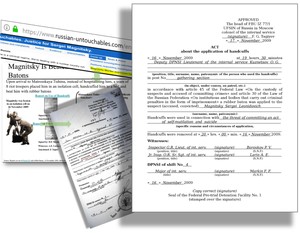
Nowhere does it say that Magnitsky was beaten to death or, curiously, even anything at all about how that lone baton was employed. And it repeats the first document verbatim that the described measures were taken, not to harm Magnitsky, but instead to stop him from harming himself.
Moreover, the second document also indicates that Magnitsky’s handcuffs were removed at 8 pm (20 hours, 00 minutes), only half an hour after they were put on at 7:30 pm (19 hours, 30 minutes), again, exactly repeating the MPOC report that he was handcuffed for that thirty minute period out of fear that he would harm himself and, not just failing to corroborate, but actually refuting Browder’s claim that Magnitsky was handcuffed and then beaten for 78 minutes till he died.
Obvious Signs of Forgery
But, the second document, D310.pdf, also has a number of idiosyncrasies which make it impossible to believe it was really used and accepted in an official capacity and, instead, mark it as an obvious forgery likely created by someone with limited knowledge of Russian by transcribing, copying, or tracing parts of the first, D309.pdf and combining them with parts similarly obtained from other documents.
• The main blocks of text in both documents are identically worded except that the phrase “special means were” in the first is replaced by “a rubber baton was” in the second.
But, while D309 is perfectly coherent, that single reference to a rubber baton in D310 makes absolutely no sense whatsoever.
Though that main body of text in D310 provides a place to write down the name of a prisoner on whom a rubber baton was used, no batons, rubber or otherwise, are mentioned anywhere else; not even in the title which instead refers only to handcuffs and is, in fact, identical to the title of the first document.
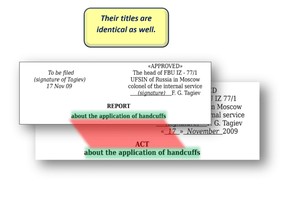
• The line on D310 asking for the name of the officer involved also strangely refers to him as “the person who used the handcuffs” without mentioning any baton. In fact, D310 contains no space to indicate who actually used that single baton it mentions only once in a paragraph otherwise identical to one from D309.
• Nor does D310 provide any space to say what was actually done with the baton it randomly drops into the description of events. A rubber baton can be used to strike a prisoner just once or repeatedly, as well as to poke, choke, trip, or merely threaten him. Yet, though handcuffs have far fewer applications, D310 exactly copies D309 in providing a space to describe how they were used but provides no space for the absolutely necessary specification of how the baton it mentions only once was.
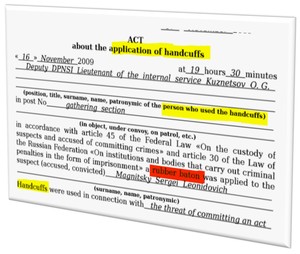
It’s not only difficult to believe that a report was submitted saying that a baton was used on Magnitsky during his final hours but leaving the question of who used it and how completely open. It’s almost impossible to believe that a form designed to report such incidents but missing a space to provide those crucial details would even be in circulation.
But it gets much worse.
• The block of virtually identical text that both documents share ends with a comma and is missing a closing parenthesis. On D309, the sentence is completed in the next line. But the next line in D310 starts a new sentence, leaving the previous one a fragment. It looks like the text on D310 must have been hastily copied from D309 without the copier noticing its incompleteness.
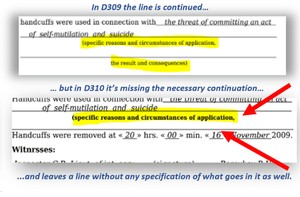
• The initial hand-written part on both forms indicates that each was filled out by O. G. Kuznetsov (Kuznetsov is a common Russian name and this isn’t police officer Artem Kuznetsov whom Browder accuses of murdering Magnitsky.) However, Kuznetsov’s signature only appears on D309.
Indeed, while D310 contains lines for the signatures of three different people, it doesn’t provide any place for the person who actually filled it out to sign. And, while it’s impossible that an official document of this nature produced circulated, used, and accepted by Russia or, for that matter, anyone else, would leave out a place for the person filling it out to sign, the fact that the second document replaces it with a space requesting the signatures of three other people turned out to be very useful for Bill Browder, indeed.
On the page where Browder links to the two documents, he lists all the names appearing on either as “Officials Sanctioning, Administering and Witnessing Magnitsky’s Beating.” And even someone who doesn’t read Russian—while having zero chance of noticing that the second form is missing a place for the person who filled out to sign—stands a very good one of being able to, without much effort, count the number of signatures appearing on each document.
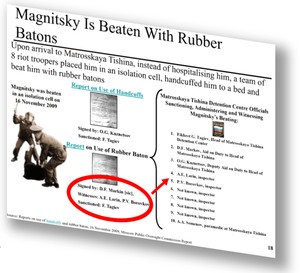
So, whoever replaced the line that any legitimate document would have had for Kuznetsov to sign with spaces for additional signatures allowed Browder to create a list of those who either “sanctioned, administered, or witnessed” Magnitsky’s alleged beating and, hence, make it appear plausible to someone who can’t read Russian that eight men really did beat Magnitsky to death.
• Finally, compare the signature line in the first form with the first handwritten line in the second: The handwriting is almost identical except the signature in the middle was removed from the first.

Their similarity would be extraordinary even if written by the same hand. Their slight differences, however, are exactly what one would expect if a copy of the signature on D309 was traced using either tracing paper or software and then used to create D310.
Moreover, exactly the same is true of every single word Lieutenant Kuznetsov is alleged to have written on D310; each and every one of them looks virtually identical to some bit of writing from D309 and, hence, could only have been traced from it.
That’s just some of the evidence that the second document Bill Browder links to is a forgery. And, forgery or not, like all the other alleged corroboration Browder has given for any of his different accounts of how Magnitsky died, it goes no way towards actually providing any and, instead, refutes the stories he’s peddling.
Browder also cites untranslated Russian transcripts of Magnitsky’s testimony to the police to verify the part of his story which provides the motive for Kuznetsov and Karpov imprisoning, torturing, and finally murdering him; namely, that he accused them of the $230 million theft from the Russian treasury.
But, when his growing suspicion and unease caused Andrei Nekrasov to examine Magnitsky’s testimony, besides discovering that Browder’s account of their content was, again, pure fiction, he also discovered the shocking full extent of Congress’s dereliction of their basic duties when they passed the Magnitsky Act and President Obama’s when he signed it.
Be sure to check RedState at 6 pm for the 5th and final installment in which, besides Bill Browder’s final monstrous lie, you also learn the real story behind Donald Trump Jr.’s infamous Trump Tower meeting with Russian Attorney Natalia Veselitskaya—something Don Jr. very likely doesn’t know himself.













Join the conversation as a VIP Member